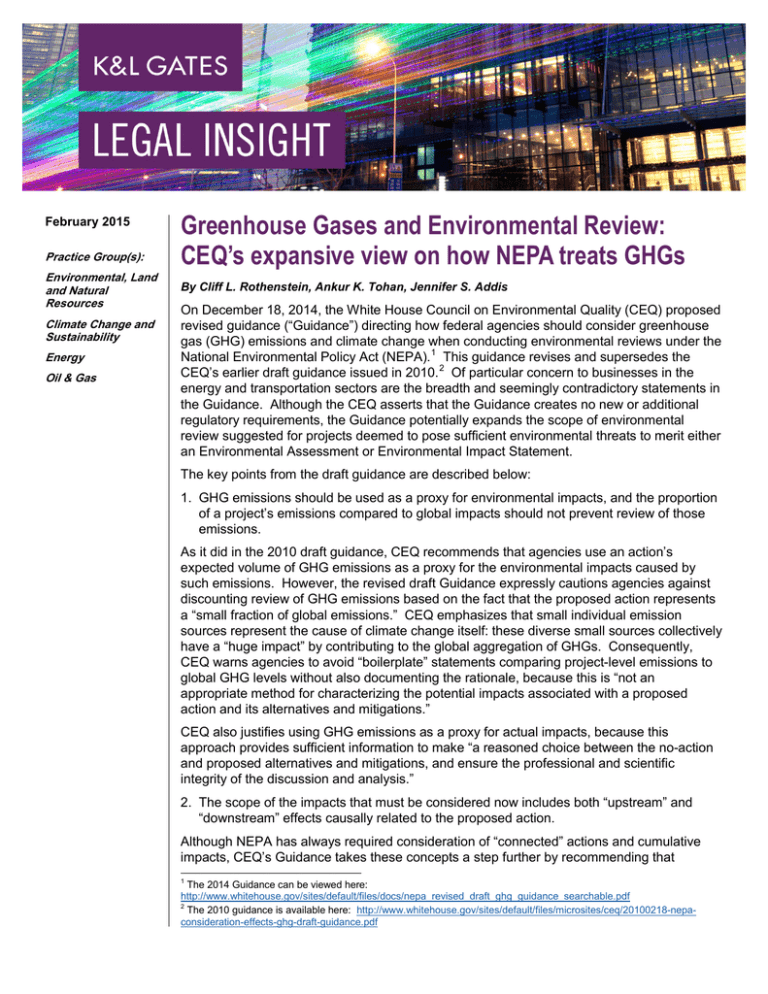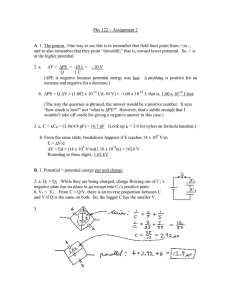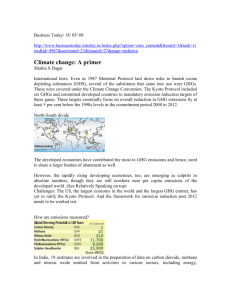
February 2015
Practice Group(s):
Environmental, Land
and Natural
Resources
Climate Change and
Sustainability
Energy
Oil & Gas
Greenhouse Gases and Environmental Review:
CEQ’s expansive view on how NEPA treats GHGs
By Cliff L. Rothenstein, Ankur K. Tohan, Jennifer S. Addis
On December 18, 2014, the White House Council on Environmental Quality (CEQ) proposed
revised guidance (“Guidance”) directing how federal agencies should consider greenhouse
gas (GHG) emissions and climate change when conducting environmental reviews under the
National Environmental Policy Act (NEPA).1 This guidance revises and supersedes the
CEQ’s earlier draft guidance issued in 2010. 2 Of particular concern to businesses in the
energy and transportation sectors are the breadth and seemingly contradictory statements in
the Guidance. Although the CEQ asserts that the Guidance creates no new or additional
regulatory requirements, the Guidance potentially expands the scope of environmental
review suggested for projects deemed to pose sufficient environmental threats to merit either
an Environmental Assessment or Environmental Impact Statement.
The key points from the draft guidance are described below:
1. GHG emissions should be used as a proxy for environmental impacts, and the proportion
of a project’s emissions compared to global impacts should not prevent review of those
emissions.
As it did in the 2010 draft guidance, CEQ recommends that agencies use an action’s
expected volume of GHG emissions as a proxy for the environmental impacts caused by
such emissions. However, the revised draft Guidance expressly cautions agencies against
discounting review of GHG emissions based on the fact that the proposed action represents
a “small fraction of global emissions.” CEQ emphasizes that small individual emission
sources represent the cause of climate change itself: these diverse small sources collectively
have a “huge impact” by contributing to the global aggregation of GHGs. Consequently,
CEQ warns agencies to avoid “boilerplate” statements comparing project-level emissions to
global GHG levels without also documenting the rationale, because this is “not an
appropriate method for characterizing the potential impacts associated with a proposed
action and its alternatives and mitigations.”
CEQ also justifies using GHG emissions as a proxy for actual impacts, because this
approach provides sufficient information to make “a reasoned choice between the no-action
and proposed alternatives and mitigations, and ensure the professional and scientific
integrity of the discussion and analysis.”
2. The scope of the impacts that must be considered now includes both “upstream” and
“downstream” effects causally related to the proposed action.
Although NEPA has always required consideration of “connected” actions and cumulative
impacts, CEQ’s Guidance takes these concepts a step further by recommending that
1
The 2014 Guidance can be viewed here:
http://www.whitehouse.gov/sites/default/files/docs/nepa_revised_draft_ghg_guidance_searchable.pdf
2
The 2010 guidance is available here: http://www.whitehouse.gov/sites/default/files/microsites/ceq/20100218-nepaconsideration-effects-ghg-draft-guidance.pdf
Greenhouse Gases and Environmental Review: CEQ’s expansive view on how
NEPA treats GHGs
agencies should consider emissions from activities that are causally “upstream” or
“downstream” of the proposed action. This approach could increase the scope of a GHG
emissions analysis significantly by requiring agencies to consider not only the emissions of
the proposed project, but also emissions associated with activities necessary to undertake
the proposed action and activities that would occur as a result of the proposed activity. By
way of example, CEQ explains in the Guidance that the GHG analysis for a proposed openpit mine would include not only emissions associated with the mining itself, but also
emissions associated with clearing the land and constructing access roads for the mine and
emissions associated with refining or processing the extracted resource and using the
resource. Thus, the GHG analysis for a mine located in West Virginia could include regional,
national, or even global emission sources, depending on the resource.
3. A GHG impact analysis now requires enhanced consideration of relevant mitigation
measures.
In addition to considering the range of reasonable alternatives that would further the purpose
and need of the proposed action, federal agencies must now also consider, where possible,
alternatives that would mitigate GHG emissions via “enhanced energy efficiency, lower
GHG-emitting technology (e.g., using renewable energy), carbon capture, carbon
sequestration (e.g., forest and coastal habitat restoration), sustainable land management
practices, and capturing or beneficially using fugitive GHG emissions such as methane.”
The guidance also suggests that agencies use mitigation monitoring to ensure that mitigation
is carried out as promised.
4. CEQ opens the door to use the social cost of carbon (SCC) as a basis to monetize the
cost-benefit/climate-related impacts of an individual project.
CEQ recommends that agencies consider the federal SCC metric as a basis to evaluate
impacts when the agency determines it appropriate to use a monetary cost/benefit analysis.
Although developed by other federal agencies in a different context, CEQ describes the SCC
as a “harmonized, interagency metric that can provide decision-makers and the public with
some context for meaningful NEPA review.” Use of this metric could have implications for
projects seeking to construct new energy or transportation facilities because of the variation
and uncertainty associated with SCC calculations.
In summary, CEQ’s new draft Guidance expands a reviewing agency’s role in considering
GHG emissions as part of an environmental review under NEPA. In addition, the draft
Guidance would require an assessment of actions beyond those under the control or
responsibility of the agency. CEQ tempers its focus on “potential effects of GHG emissions”
and “implications of climate change” with a restatement about how agencies exercise their
NEPA authority: “Agencies continue to have substantial discretion in how they tailor their
NEPA processes to accommodate the concerns raised in this guidance, consistent with the
CEQ Regulations and their respective implementing regulations and policies, so long as they
provide the public and decision-makers with explanations of the bases for their
determinations.” However, if the previous 2010 draft guidance provides any indication,
agencies are likely to look to this Guidance to inform how they conduct their environmental
reviews.
It is unclear when—if at all—CEQ will finalize its draft Guidance (the Guidance is open to
public review and comment through March 25, 2015). However, even if the Guidance never
2
Greenhouse Gases and Environmental Review: CEQ’s expansive view on how
NEPA treats GHGs
becomes final, federal and state agencies may rely on its recommendations when
conducting environmental reviews, as they have on the previous 2010 draft guidance.
Authors:
Cliff L. Rothenstein
cliff.rothenstein@klgates.com
+1.202.778.9381
Ankur K. Tohan
ankur.tohan@klgates.com
+1.206.370.7658
Jennifer S. Addis
jennifer.addis@klgates.com
+1.206.370.8068
Anchorage Austin Beijing Berlin Boston Brisbane Brussels Charleston Charlotte Chicago Dallas Doha Dubai Fort Worth Frankfurt
Harrisburg Hong Kong Houston London Los Angeles Melbourne Miami Milan Moscow Newark New York Orange County Palo Alto Paris
Perth Pittsburgh Portland Raleigh Research Triangle Park San Francisco São Paulo Seattle Seoul Shanghai Singapore Spokane
Sydney Taipei Tokyo Warsaw Washington, D.C. Wilmington
K&L Gates comprises more than 2,000 lawyers globally who practice in fully integrated offices located on five
continents. The firm represents leading multinational corporations, growth and middle-market companies, capital
markets participants and entrepreneurs in every major industry group as well as public sector entities, educational
institutions, philanthropic organizations and individuals. For more information about K&L Gates or its locations,
practices and registrations, visit www.klgates.com.
This publication is for informational purposes and does not contain or convey legal advice. The information herein should not be used or relied upon in
regard to any particular facts or circumstances without first consulting a lawyer.
© 2015 K&L Gates LLP. All Rights Reserved.
3






